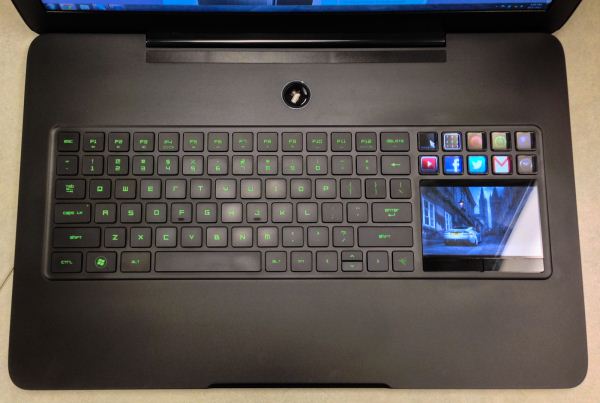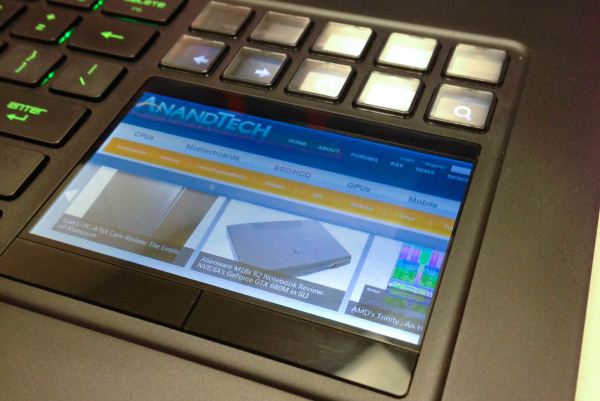The New Razer Blade: Thoroughly Reviewed
by Vivek Gowri on October 3, 2012 5:40 PM ESTRazer Blade (late 2012) - Switchblade UI
Easily the most significant issue I had with the original Blade’s user experience while I had it was the usability of the Switchblade UI system, and other than the overall system value quotient, it was the biggest reason I could point to for not recommending a Blade purchase. By “usability of the Switchblade UI”, I’m not even saying that it was hard to use, just that it was never working reliably enough for me to use on a day-to-day basis. Synapse, Razer’s cloud-driven device settings manager, would crash with regularity, and the entire system had issues coming out of standby mode.
The good thing here is that the Synaptics drivers were pretty solid, so you could still use the touchpad part of it even when Synapse and Switchblade were long gone. Of course, there were also the occasional times when Switchblade would nuke itself completely (to use the technical term for it)—the LCD buttons would turn white and the touch panel would become unresponsive, necessitating a full system reboot. Through my three months with the original Blade, I probably spent two-thirds of my time with the Switchblade part of things not working. I didn’t care most of the time as long as the multitouch trackpad was working, but it was definitely a significant problem that needed to be addressed going forward.
I wasn’t the only one who noticed this, as Razer took a beating in various online notebook owner forums. Thankfully, the company was very proactive about pushing new updates and new content to Switchblade. Based on my interactions with the new Blade and also the DeathStalker Ultimate keyboard over the last month, it’s definitely a night and day difference in terms of stability and usability.
This is a very, very good thing. So is the new SDK that was released by Razer, something that will become an asset as more Switchblade devices hit the market. There are a couple of new applications, including a game timer and a screenshot app. Razer is also working with a number of game developers to add support for a number of popular titles, including CounterStrike, CS:Source, CS:GO, Team Fortress 2, Battlefield 3, and Star Wars: Knights of the Old Republic at present, with more games currently in validation. And call me shallow, but I find the new ability to set your own wallpaper for the LCD touchpad simply awesome.
But here’s my deal. Even with all of the improvements being made to Switchblade, it’s still a cool concept with only a very specific usage model. Even then, a lot of the experiences are subpar—the browser is still Mobile IE 7 running on an embedded Windows NT 5.1 kernel, and it absolutely pales in comparison to basically any modern smartphone browsing experience. The Gmail, YouTube, Facebook, and Twitter applications are just the mobile IE 7 experiences, which makes them generally painful to use, but it's also worth noting that YouTube videos played back at a very low frame rate, 20 frames per second or less. Any iPhone or iPod touch (going all the way back to the ARM11-based originals from 2007) will top that. So will the Zune HD or any credible Android/Windows Phone/WebOS device made in the last three years.
It’s a blatant issue—it’s far easier and more convenient to just pull out a smartphone or an iPod to check the internet, email, or social networks. The gaming functions are nice enough, as is the screenshot application, and I suspect we’ll see Switchblade get more useful as developers come aboard and more games-specific applications are launched. The game developers can do some pretty innovative things with Switchblade; we were shown a demo of the Firefall application that allowed you to use the touchscreen as either a virtual analog controller or showed the environment map, for example.
Switchblade clearly has the potential to enhance gaming experiences, but it’s just as clear that it needs a lot of work in other areas. I enjoy the idea of having a touchscreen input, along with the configurable shortcut keys at the top. The placement, too, is very convenient and is much more natural to use than a traditionally placed touchpad once you get used to it. But with such outdated software experiences powering the core web-based functions of Switchblade, it’s sadly going to remain a novel but not particularly functional sideshow outside of its uses in the gaming realm.
If you look solely at the keyboard and mouse, things look pretty solid. The touchscreen trackpad, like I said above, is great to use; Synaptic’s multitouch drivers are seamless and offer a wide range of gesture support. Razer has improved the touchpad buttons to give much more positive feedback on clicks—there’s less of a cheap plastic sound when you actuate them. The keyboard is almost untouched, meaning fully anti-ghosted and individually backlit keys that have zero flex, though the key travel itself is a bit shallow. Razer has backlit the secondary functions (brightness, volume, etc), which has made using them in the dark significantly more convenient. I still take issue to the layout (seriously, there’s little to no reason for the Fn key to be on the right side of the spacebar) but you get used to it quickly enough as long as you aren’t switching from notebook to notebook.













59 Comments
View All Comments
Rezurecta - Thursday, October 4, 2012 - link
One question. Do you think MBP's are overpriced?ahamling27 - Thursday, October 4, 2012 - link
They sure are, but if you want OSX on a laptop, you don't have much choice. You can get a better W7 gaming laptop for much cheaper.solinear - Thursday, October 4, 2012 - link
This kind of comment reminds me of the late 90s linux users, who bragged about how they spent $150 less on their systems and could do "everything I could" (except use software)... then a few years later went out and spent $2000 on a Mac with OSX and talked about how awesome it was and suddenly the price argument they previously had was not only not there, but they refused to discuss price when I brought that up.Price is important, but it's just part of a package. I think that the Razer package is probably worth ~$2000, though I might go with an HP instead (Alienware feels legacy to me) when I buy a new laptop. However, this is definitely on my short list for laptops.
The feature set is really nice and the fact that I wouldn't have to go "Which one of these ports is USB3 again?" or move a device out of a port to use the one that I need for something is more than a small amount of convenience.
Basically this laptop has everything that I'd want for the next 2-3 years in a laptop except for the SSD and RAM. Like others said, I'd rather have 16+GB RAM and an OS/apps drive that is a 256GB SSD and a platter-based disk for data or apps that I am not as concerned about performance on. That's what we did with my wife's HP laptop and we couldn't be happier with it.
Clockwurk - Thursday, October 4, 2012 - link
The problem with them making a "premium" product is that they aren't using "premium" parts. They are using middle of the road hardware and calling it "premium". That's what I have a problem with.Seems to work well enough for Apple, no?
ahamling27 - Thursday, October 4, 2012 - link
Yes, but with Apple your buying OSX not a W7 gaming machine. You're comparing apples to oranges, no pun intended, and it does work well for them.Except the rMBP has a better screen, faster processor, industry leading trackpad, but the gpu is a 650(for what it's worth, it's overclocked an extra 165 mhz). Plus, it's about $300 cheaper, and you have the option of a larger SSD.
Zap - Friday, October 5, 2012 - link
Buying ANY notebook computer is picking form over function. If you want highest performance for a lower price while still keeping some sense of portability, then build a mini ITX gaming rig. Remember that Silverstone SG05 that was reviewed in the past couple months? You can build one with an overclocked Core i7 and GTX 680, with a lot more storage space too.What's the point? Any computer choice is always a tradeoff. Pick your poison.
santeana - Thursday, October 4, 2012 - link
Why comment? It is a valid point. I happen to agree with him. For just over half that price you can get the same chip with a premium display and your choice of AMD 7970m or NV GTX685m and it's only slightly thicker than this one. It's certainly a nice machine and I like the sleekness of it, but honestly it looks similar to the Sager/Clevo I just described and it's hundreds of dollars more.N4g4rok - Wednesday, October 3, 2012 - link
Personally, i wish more laptops did that with the trackpad. The placement makes more sense when you're use to mouse and keyboard. That, and i won't hit it while i'm typing.inighthawki - Wednesday, October 3, 2012 - link
I'd prefer a numpad there myself.HisDivineOrder - Wednesday, October 3, 2012 - link
Ditto.